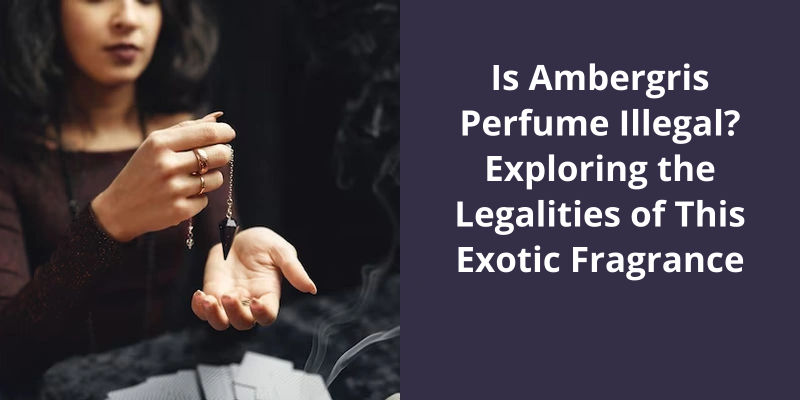Ambergris, a coveted ingredient in the world of perfumes, has long remained a subject of ambiguity in terms of it’s legal status. It’s unique scent and rarity have made it a prized possession, but the question remains: is ambergris perfume illegal? The answer to this query is multifaceted, as the legality of ambergris trade varies from country to country. While it isn’t covered in CITES provisions, which regulate the trade of endangered species, several nations have taken measures to restrict it’s possession and trade. India, Australia, and the United States, for instance, have established legal frameworks that prohibit the commerce and possession of ambergris within their borders. By exploring the legalities surrounding this exotic fragrance ingredient, we can gain a comprehensive understanding of the complex regulations governing it’s use.

Is Real Ambergris Still Used in Perfume?
Ambergris, often referred to as the “floating gold,” is a rare and highly sought-after ingredient in the perfume industry. However, the legality surrounding the use of real ambergris in perfume has been a topic of debate for years. While some countries have banned the use of natural ambergris due to ethical concerns, others permit it’s usage under certain regulations.
This practice ensures that the use of ambergris doesn’t contribute to illegal whaling or harm endangered species.
However, it’s important to note that the possession and sale of ambergris may still be regulated or restricted in some countries. For instance, countries within the European Union require permits or certifications for the import and export of ambergris. This ensures the transparency and legality of it’s origin.
Synthetic ambergris is chemically engineered to replicate the unique aroma of natural ambergris. This innovation allows perfumers to create similar scents without relying on the use of real ambergris.
The decision to use natural or synthetic ambergris ultimately rests with the perfumer.
However, the possession and sale of this ingredient may be regulated or restricted in some regions.
The Process of Extracting and Harvesting Natural Ambergris.
Ambergris is a rare and highly valued substance used in perfumery. It’s produced in the digestive systems of sperm whales and is expelled through their feces. Once expelled, this unique substance floats in the ocean and undergoes a transformation process over many years, turning into a waxy substance with a distinct scent.
The harvesting of ambergris is a complex and challenging process. Since sperm whales are protected under international law, the extraction of ambergris must adhere to strict guidelines. The most common method of retrieval is by searching coastlines where the substance may have washed ashore after being released by whales.
Ambergris is considered an illegal substance in some countries due to it’s association with endangered species and the ethical concerns surrounding it’s procurement. However, many countries allow the use of ambergris in perfumery as long as it’s sourced legally and responsibly.
It’s essential for perfume companies to ensure that the ambergris they use is obtained legally and ethically. This involves closely monitoring the supply chain to guarantee that no harm has been done to whales in the process. By following these guidelines, perfume manufacturers can continue to create unique and luxurious fragrances while respecting the legalities and conservation efforts associated with ambergris.
During the late 20th century, a pivotal shift took place in the perfumery industry that saw the decline of ambergris usage.
When Did They Stop Using Ambergris in Perfume?
Ambergris, a rare and mysterious substance derived from the digestive system of sperm whales, has long been celebrated for it’s alluring fragrance. For centuries, it was highly sought-after and considered a luxurious ingredient in the world of perfumery. The use of ambergris in perfume can be traced back to the 1600s, and it continued to be a popular addition well into the 20th century.
However, as the world became more aware of the environmental impact of whaling and the need to protect these magnificent creatures, concerns were raised about the ethical sourcing of ambergris. Sperm whales were hunted for their oil and blubber, endangering their populations. As a result, laws and regulations were implemented to restrict the use of ambergris in perfumes.
The Convention on International Trade in Endangered Species of Wild Fauna and Flora (CITES) listed sperm whales as an endangered species, further tightening the restrictions on ambergris trade.
This shift in the industry can be attributed to a growing awareness of the need for conservation and sustainability.
While synthetic alternatives may mimic the aroma of natural ambergris, they can’t replicate it’s complexity and depth. The ban on using real ambergris in perfumes has undoubtedly changed the fragrance landscape, but it’s also prompted perfumers to explore new creative avenues and develop innovative scent combinations.
The industry has since adapted, inspiring perfumers to explore new scent profiles and innovate to capture the allure of this once highly coveted ingredient.
The History of Ambergris and It’s Use in Perfumery
Ambergris is a fascinating substance that’s been used in perfumery for centuries. It’s a waxy, grayish substance that’s produced in the digestive system of sperm whales. When the whales excrete it, it floats in the ocean until it eventually washes up on shores. Historically, it was prized for it’s unique aroma, which is described as musky and earthy.
Ambergris has been used as a fixative in perfumes, helping to extend their longevity and enhance their scent. It adds depth and complexity to fragrances, often described as providing a smooth, rich, and animalistic quality. It’s been valued by perfumers for it’s ability to enhance the other ingredients in a perfume, creating a more balanced and well-rounded scent.
However, the legalities surrounding ambergris are complex and vary from country to country. In some places, it’s considered illegal to possess or trade ambergris, as it’s derived from an endangered species. In other countries, such as the United States, it isn’t specifically illegal, but it’s sourcing and sale may be regulated under laws such as the Endangered Species Act and the Marine Mammal Protection Act.
Many perfumers now choose to use synthetic alternatives to ambergris in their fragrances, due to ethical concerns and legal restrictions. These synthetic substitutes aim to recreate the unique scent and characteristics of ambergris without harming whales or violating any laws.
So, while ambergris has a long and storied history in perfumery, it’s use in modern times is subject to legal and ethical considerations. Perfumers must navigate these complexities to create fragrances that are both legal and sustainable.
Conclusion
This is because it’s considered a naturally excreted waste product, and it’s trade is legal in many other countries. Therefore, the legality of ambergris perfume largely depends on the specific country in question. It’s always advisable for individuals to research and understand the laws and regulations surrounding ambergris trade and possession in their respective regions to ensure compliance.





